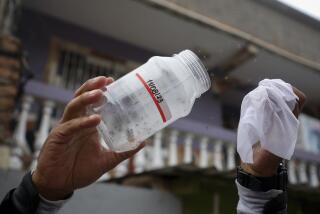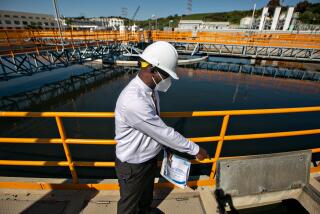Device Worth Its Salt, Creates Safe Water : Health: Creators say their simple device has the potential to fight epidemics of cholera and other waterborne disease, for just pennies a week.
- Share via
WASHINGTON — Salt, a small generator and a germ-resistant water bucket are helping villagers in the mountains of Bolivia turn a contaminated river into safe drinking water.
Its creators say the simple experiment has the potential to fight world epidemics of cholera and other waterborne disease, for pennies a week.
“This is a low-tech, low-budget approach that . . . empowers these people to protect themselves,” said Dr. Eric Mintz, an epidemiologist at the U.S. Centers for Disease Control and Prevention.
The Pan-American Health Organization considers the new system so promising that it’s starting similar projects in Colombia, Nicaragua and the Dominican Republic in May. Officials in India, where a devastating new strain of cholera hit last year, also are interested.
“We’re confident it’s going to change the quality of the water,” said Fred Reiff, a water expert at the health organization, which helped CDC pay for the system. “And it will cost a family less than $2 per year.”
Some 1.5 billion people, mostly in developing countries, drink water tainted by sewage, natural bacteria and parasites.
Although boiling water kills bacteria, it doesn’t kill many parasites, and many places have no firewood. Importing chlorine is expensive and doesn’t stop family members from reinfecting the household water bucket by dipping water with dirty hands or cups--a big problem in the recent Latin American cholera epidemic.
The new plan, tested in the Bolivian villages of El Alto and Huaricana, attacks both problems.
A small generator, through electrolysis, turns ordinary salt and water into a disinfectant that makes water drinkable in about an hour.
The generator uses about as much electricity as a 120-watt light bulb and in 12 hours produces enough disinfectant to last 500 people a month.
CDC determined the best germ-resistant jug holds five gallons, enough to last a family one day; has a two-inch opening to pour in water but is too small for hands; has a large spigot at the bottom, and is lightweight and unbreakable.
An Ohio company sells campers that very jug.
“What’s unique is combining the treatment with the vessel,” Mintz said. “Either one alone may not be enough.”
But to be cheap enough to work, communities must produce the disinfectant and water jugs locally. So CDC and the U.S. jug-maker, Toledo-based Tolco Corp., are negotiating a licensing agreement to allow Bolivians to copy the jug, for a small royalty.
The Pan-American Health Organization is raising funds to help communities buy the generators for about $2,500 apiece.
The University of North Carolina is busy studying just how strong a disinfectant to brew. The same generator will make two different types of disinfectant, depending on the metal in its electrolysis cell.
A stainless steel cell produces a mild chlorine, the kind used to disinfect U.S. water. An iridium or titanium cell produces a stronger mixture of chlorine, ozone, chlorine dioxide and hydrogen peroxide. It quickly kills very strong parasites like cryptosporidium, the organism that caused 400,000 Milwaukee residents to get sick last year.
But mixed oxidants haven’t been thoroughly studied, and they may be stronger than necessary, especially when the $200 mixed-oxidant cell needs to be replaced at least five times as often as the chlorine cell, said university researcher Linda Venczel.
CDC cautions that the system still poses questions. The agency is just beginning to collect data determining whether fewer villagers get sick after starting to use the water system.
But the Pan-American Health Organization says the disinfectant does clean the water and the water jug keeps people from recontaminating it--enough proof to forge ahead.
“It’s going to take a long time for these areas to get good central water systems,” Reiff said. “This is an interim solution that they can afford and that will keep people healthy.”
More to Read
Sign up for Essential California
The most important California stories and recommendations in your inbox every morning.
You may occasionally receive promotional content from the Los Angeles Times.










